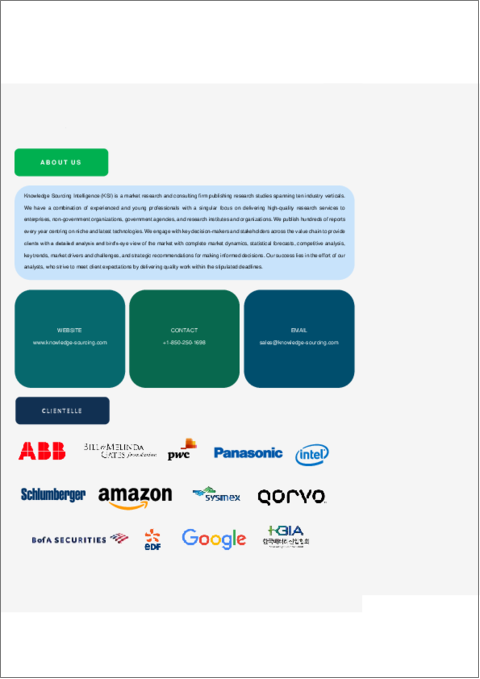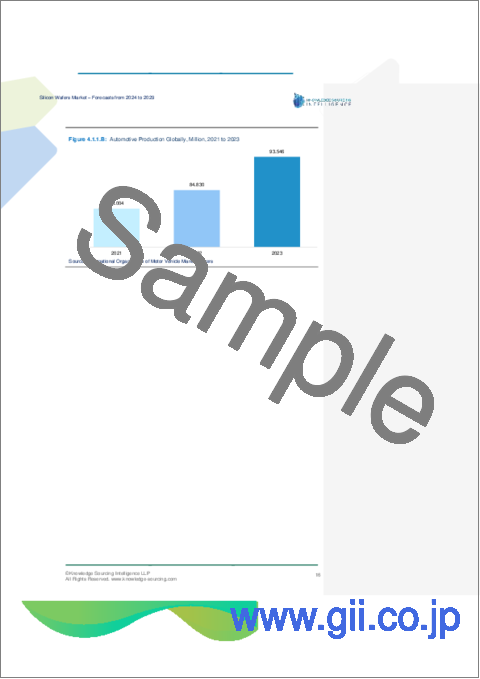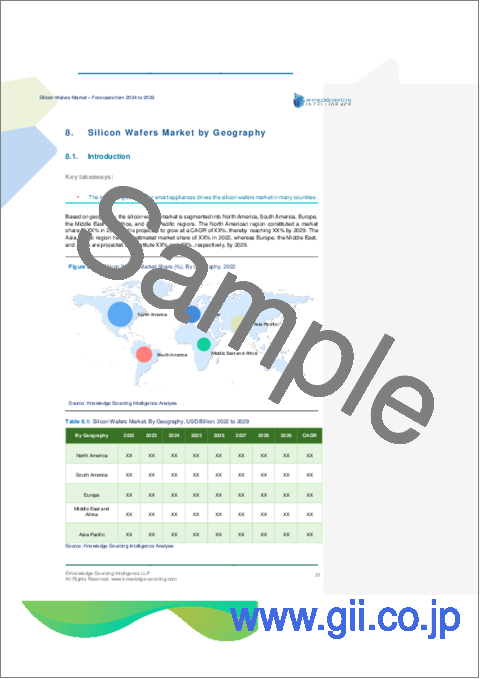|
|
市場調査レポート
商品コード
1457081
シリコンウエハー市場-2024年から2029年までの予測Silicon Wafers Market - Forecasts from 2024 to 2029 |
||||||
カスタマイズ可能
|
|||||||
| シリコンウエハー市場-2024年から2029年までの予測 |
|
出版日: 2024年02月08日
発行: Knowledge Sourcing Intelligence
ページ情報: 英文 124 Pages
納期: 即日から翌営業日
|
全表示
- 概要
- 目次
シリコンウエハー市場は、2022年に81億7,600万米ドルと評価され、CAGR 5.52%で成長し、2029年には134億9,000万米ドルの市場規模に達します。
シリコンウエハーは、あらゆる種類の電子機器や電子部品に使用されています。この技術は、集積回路やマイクロエレクトロニクスの製造に使用されます。微細加工中、シリコンウエハーはマイクロエレクトロニクス部品間の基板として機能し、ドーピング、イオン注入、エッチングなど、他の多くの微細加工プロセスも行います。よりコンパクトな電子機器への要求から、高度な微細化が進んでいます。消費者の期待が世界的に高まっていることに加え、スマートフォン、スマート・ウェアラブル、PC、スマート・ホーム・デバイス、その他のインテリジェント・ガジェットなどの高度な技術機器によって、コンシューマー・エレクトロニクスの重要な市場が引き続き牽引されます。新興諸国の可処分所得が増加し、これらのデバイスが受け入れられることで、途上国におけるシリコンウエハー需要が大幅に増加します。米国政府による半導体産業への投資は、この地域の展望を大きく押し上げると考えられます。米国上院は2021年5月、中国に対抗するための広範な取り組みの一環として、国内半導体生産の強化に520億米ドルを投資すると発表しました。さらに、アジア太平洋における自動車人気の高まりは、より多くの住民が自動車やその他の自動車を購入できるようになったという事実からも明らかであり、その結果、半導体の需要が高まっています。同地域の半導体需要により、シリコンウエハー市場の収益は増加しています。
アジア太平洋は民生用電子機器と自動車セグメントで増加傾向にあります。携帯電話、テレビ、デジタルカメラなどの家電製品は、中国、インド、日本、インドネシア、フィリピンなどの経済成長により需要が急増しています。例えば、2020年にはアジアのGDPがその他のGDPを上回ると予想されています。この地域が現在のペースで成長を続ければ、世界の成長率は2030年までに60%に達すると予想されています。(出典:weforum.org)
市場の促進要因:
- 自動車需要の増加が市場を牽引すると予想されます。
世界のシリコンウエハー市場を牽引する主要要因は、自動車需要の増加と製造活動の活発化です。ハイブリッド車や電気自動車への移行は、自動車需要と製造の増加によるものです。自動車セグメントへの新技術の開発・導入も、業界の発展に寄与する他の要因です。自動車産業は、成長するとアンチ・ブレーキ・システムを搭載した自動車を記載しています。このような技術革新は、シリコンウエハーの推進力を支えています。従って、市場の成長は、将来にわたってこれらの要因によって支えられています。2030年までに2億台以上の電気乗用車が走行すると予測されているが、これは2016年の200万台強の急増です。2030年には、2輪、3輪、4輪の電気自動車が9億台走る可能性があり、これは4輪車の数を上回ります。こうした成長は、シリコンウエハーサプライヤーに多くの機会を提供し、市場の成長を後押しします。
- 半導体需要の伸び
シリコンウエハー市場は、半導体に対するニーズの高まりから直接的かつ大きな影響を受けています。半導体製造に不可欠な基板であるシリコンウエハーの需要は、半導体を主要部品とする電子機器や技術の普及と連動して高まっています。生産者は半導体産業の拡大する需要を満たすために努力しており、この急増はシリコンウエハー製造量の増加に反映されています。より低いナノメートルプロセスへの移行など、半導体技術の向上は、これらのセクター間の複雑なつながりを浮き彫りにし、より高い精度と広い幅を持つシリコンウエハーの必要性を生み出しています。
市場抑制要因:
- 高コストとメンテナンス:
シリコンウエハーベンダーが直面する大きな課題は、高額な初期投資とその見返りのなさです。さらに、半導体製造用の薄いシリコンウエハーは取り扱いが難しく、外部で機械的に支える必要があるため、プロセッサーが450 mmのシリコンウエハーを扱うのはさらに難しくなります。そのため、リジッドキャリアウエハー、特別に設計されたチャック、ダイシングテープを使用する必要があり、予算オーバーとなります。さらに、最終製品のパッケージングが煩雑であることも市場の妨げとなっています。
北米は主要な地域市場になると予想されています。
同地域の技術的躍進と活況を呈する半導体部門が北米シリコンウエハー市場を牽引しています。北米には大手半導体メーカーや技術主導型企業が集中しているため、半導体の製造に不可欠な部品であるシリコンウエハーに対するニーズが安定しています。この地域の研究開発への熱心さは、半導体技術のフロンティアを拡大するための継続的なプロジェクトによってさらに市場を刺激しています。
主要発展:
- 2023年12月、Tokyo Electronは300ウェハー対応のウエハー薄化装置「UlucusTM G」を発表しました。半導体製造における高度なパターニングには、シリコンウエハーの平坦性向上が必要です。
- 2023年8月、Mitsubishi Electric Corporationはパワーデバイス向けパワー半導体を生産する福山製作所において、同社初となる12インチシリコンウエハの加工ラインが完成したと発表しました。また、同ラインで生産されるパワー半導体チップは、必要な性能基準を満たしていることがサンプル製造・試験により確認されています。
目次
第1章 イントロダクション
- 市場概要
- 市場の定義
- 調査範囲
- 市場セグメンテーション
- 通貨
- 前提条件
- 基準年と予測年のタイムライン
- 利害関係者にとっての主要メリット
第2章 調査手法
- 調査デザイン
- 調査プロセス
第3章 エグゼクティブサマリー
- 主要調査結果
- CXOの視点
第4章 市場力学
- 市場促進要因
- 市場抑制要因
- ポーターのファイブフォース分析
- 業界バリューチェーン分析
- アナリストビュー
第5章 シリコンウエハー市場:ウエハーサイズ別
- イントロダクション
- 0~100mm
- 100~200mm
- 200~300mm
- 300mm以上
第6章 シリコンウエハー市場:製法別
- イントロダクション
- チョクラルスキー技法(Cz)
- ブリッジマン法
- フロートゾーン
- その他
第7章 シリコンウエハー市場:業界別
- イントロダクション
- 家電
- 自動車
- 製造業
- 通信
- その他
第8章 シリコンウエハー市場:地域別
- イントロダクション
- 北米
- 南米
- 欧州
- 中東・アフリカ
- アジア太平洋
第9章 競合環境と分析
- 主要企業と戦略分析
- 市場シェア分析
- 合併、買収、合意とコラボレーション
- 競合ダッシュボード
第10章 企業プロファイル
- Siltronic
- Sumco Corporation
- Shin-Etsu Chemical Co., Ltd.
- Okmetic
- GlobalWafers(Sino-American Silicon)
- Silicon Materials, Inc
- Wafer Works Corporation
- Wafer World
- Virginia Semiconductor, Inc.
The silicon wafers market is evaluated at US$8.176 billion for the year 2022 growing at a CAGR of 5.52% reaching the market size of US$13.49 billion by the year 2029.
All types of electronic devices and components contain silicon wafers. The technology is used to fabricate integrated circuits and microelectronics. During microfabrication, silicon wafers function as substrates between microelectronic components as well as perform many other microfabrication processes such as doping, ion implantation, and etching. A high degree of miniaturization has resulted from the demand for more compact electronics. In addition to consumer expectations growing worldwide, a significant market for consumer electronics will continue to be driven by advanced technological devices such as smartphones, smart wearables, PCs, smart home devices, and other intelligent gadgets. Increasing disposable incomes and the acceptance of these devices will increase silicon wafer demand substantially in developing countries. US government investments in the semiconductor industry will significantly boost regional prospects. The U.S. Senate announced it would invest USD 52 billion in strengthening domestic semiconductor production as part of a broader effort to compete against China in May 2021. Furthermore, the growing popularity of automobiles in APAC is evident in the fact that more residents can now afford cars and other automobiles, resulting in a demand for semiconductors. There has been an increase in revenues generated by the silicon wafer market due to the demand for semiconductors in the region.
APAC is on the rise in the consumer electronics and automotive sectors. Consumer electronics like mobile phones, TVs, digital cameras, and many others are experiencing a surge in demand due to economic growth in countries like China, India, Japan, Indonesia, and the Philippines. For instance, the GDP of Asia will surpass the GDP of the rest of the world combined in 2020. Global growth is expected to reach 60% by 2030 if the region continues to grow at its current pace. (Source: weforum.org)
MARKET DRIVERS:
- A rise in demand for automobiles is anticipated to propel the market.
Among the key factors driving the global silicon wafer market are increasing vehicle demand and an increase in manufacturing activity. The move towards hybrid and electric vehicles is due to higher vehicle demands and manufacturing. Developing and introducing new technologies into the automotive sector were other factors contributing to the development of the industry. The automotive industry offers vehicles with an anti-braking system when it grows. Innovations such as these support the drive for silicon wafers. The market's growth is therefore supported by these factors going forward into the future. Over 200 million electric passenger cars are predicted to be on the road by 2030, a rapid increase of just over 2 million vehicles in 2016. By 2030, there could be 900 million electric two-, three---, and four-wheeled vehicles on the road, which is more than the number of four-wheeled cars. (Source: irena.org). These augmentations will consequently offer numerous opportunities to silicon wafer suppliers thus, boosting their market growth.
- Growth in demand for semiconductors.
The silicon wafers market is directly and significantly impacted by the growing need for semiconductors. The requirement for silicon wafers, the essential substrate for semiconductor manufacture, rises in tandem with the proliferation of electronic gadgets and technologies that rely on semiconductors as their key components. As producers work to satisfy the expanding demands of the semiconductor industry, this surge is reflected in higher silicon wafer manufacturing quantities. Improvements in semiconductor technology, such as the shift to lower nanometer processes, highlight the complex link between these sectors and create a need for silicon wafers with greater accuracy and wider widths.
MARKET RESTRAINTS:
- High cost and maintenance:
A high initial investment coupled with a questionable lack of returns is a major challenge facing silicon wafer vendors. Furthermore, thin silicon wafers for semiconductor fabrication are difficult to handle and must be supported mechanically outside, which makes it even more difficult for processors to handle 450 mm silicon wafers. This means it becomes necessary to use rigid career wafers, specially designed chucks, and dicing tape, thus exceeding budget expectations. Furthermore, the final product packaging is cumbersome hampering the market.
North America is anticipated to be the major regional market.
The region's technical breakthroughs and booming semiconductor sector drive the North American silicon wafers market. North America has a concentration of large semiconductor manufacturers and technology-driven businesses, which means that there is a steady need for silicon wafers, which are essential components in the creation of semiconductors. The market is further stimulated by the region's dedication to research and development, as continuous projects concentrate on expanding the frontiers of semiconductor technology.
Key Developments:
- In December 2023, Tokyo Electron announced the release of UlucusTM G, a wafer-thinning system for 300-wafer production. Greater flatness in silicon wafers is necessary for advanced patterning in semiconductor fabrication. Integrated wafer manufacturing equipment that can execute various operations automatically and continuously is preferred due to the worldwide labor shortage trend.
- In August 2023, Mitsubishi Electric Corporation announced that the construction of its first 12-inch silicon wafer processing line at its Fukuyama Factory, which produces power semiconductors for Power Device Works, has been completed. Furthermore, it has been confirmed by sample manufacturing and testing that the power semiconductor chips produced on this line of production meet the necessary performance standards.
Segmentation:
By Wafer Size
- 0- 100 mm
- 100 - 200 mm
- 200 - 300 mm
- More than 300 mm
By Fabrication Method
- Czochralski Technique (Cz)
- Bridgeman Method
- Float-Zone
- Others
By Industry Vertical
- Consumer Electronics
- Automotive
- Manufacturing
- Telecommunications
- Others
By Geography
- North America
- USA
- Canada
- Mexico
- Others
- South America
- Brazil
- Argentina
- Others
- Europe
- France
- Germany
- UK
- Italy
- Others
- Middle East and Africa
- Saudi Arabia
- UAE
- Israel
- Others
- Asia Pacific
- China
- India
- South Korea
- Taiwan
- Thailand
- Indonesia
- Japan
- Others
TABLE OF CONTENTS
1. INTRODUCTION
- 1.1. Market Overview
- 1.2. Market Definition
- 1.3. Scope of the Study
- 1.4. Market Segmentation
- 1.5. Currency
- 1.6. Assumptions
- 1.7. Base, and Forecast Years Timeline
- 1.8. Key Benefits to the stakeholder
2. RESEARCH METHODOLOGY
- 2.1. Research Design
- 2.2. Research Processes
3. EXECUTIVE SUMMARY
- 3.1. Key Findings
- 3.2. CXO Perspective
4. MARKET DYNAMICS
- 4.1. Market Drivers
- 4.2. Market Restraints
- 4.3. Porter's Five Forces Analysis
- 4.3.1. Bargaining Power of Suppliers
- 4.3.2. Bargaining Power of Buyers
- 4.3.3. Threat of New Entrants
- 4.3.4. Threat of Substitutes
- 4.3.5. Competitive Rivalry in the Industry
- 4.4. Industry Value Chain Analysis
- 4.5. Analyst View
5. SILICON WAFERS MARKET, BY WAFER SIZE
- 5.1. Introduction
- 5.2. 0-100 mm
- 5.2.1. Market Trends and Opportunities
- 5.2.2. Growth Prospects
- 5.2.3. Geographic Lucrativeness
- 5.3. 100-200 mm
- 5.3.1. Market Trends and Opportunities
- 5.3.2. Growth Prospects
- 5.3.3. Geographic Lucrativeness
- 5.4. 200-300 mm
- 5.4.1. Market Trends and Opportunities
- 5.4.2. Growth Prospects
- 5.4.3. Geographic Lucrativeness
- 5.5. More than 300 mm
- 5.5.1. Market Trends and Opportunities
- 5.5.2. Growth Prospects
- 5.5.3. Geographic Lucrativeness
6. SILICON WAFERS MARKET, BY FABRICATION METHOD
- 6.1. Introduction
- 6.2. Czochralski Technique (Cz)
- 6.2.1. Market Trends and Opportunities
- 6.2.2. Growth Prospects
- 6.2.3. Geographic Lucrativeness
- 6.3. Bridgeman Method
- 6.3.1. Market Trends and Opportunities
- 6.3.2. Growth Prospects
- 6.3.3. Geographic Lucrativeness
- 6.4. Float-Zone
- 6.4.1. Market Trends and Opportunities
- 6.4.2. Growth Prospects
- 6.4.3. Geographic Lucrativeness
- 6.5. Others
- 6.5.1. Market Trends and Opportunities
- 6.5.2. Growth Prospects
- 6.5.3. Geographic Lucrativeness
7. SILICON WAFERS MARKET, BY INDUSTRY VERTICAL
- 7.1. Introduction
- 7.2. Consumer Electronics
- 7.2.1. Market Trends and Opportunities
- 7.2.2. Growth Prospects
- 7.2.3. Geographic Lucrativeness
- 7.3. Automotive
- 7.3.1. Market Trends and Opportunities
- 7.3.2. Growth Prospects
- 7.3.3. Geographic Lucrativeness
- 7.4. Manufacturing
- 7.4.1. Market Trends and Opportunities
- 7.4.2. Growth Prospects
- 7.4.3. Geographic Lucrativeness
- 7.5. Telecommunications
- 7.5.1. Market Trends and Opportunities
- 7.5.2. Growth Prospects
- 7.5.3. Geographic Lucrativeness
- 7.6. Others
- 7.6.1. Market Trends and Opportunities
- 7.6.2. Growth Prospects
- 7.6.3. Geographic Lucrativeness
8. SILICON WAFERS MARKET, BY GEOGRAPHY
- 8.1. Introduction
- 8.2. North America
- 8.2.1. By Wafer Size
- 8.2.2. By Fabrication Method
- 8.2.3. By Industry Vertical
- 8.2.4. By Country
- 8.2.4.1. USA
- 8.2.4.1.1. Market Trends and Opportunities
- 8.2.4.1.2. Growth Prospects
- 8.2.4.2. Canada
- 8.2.4.2.1. Market Trends and Opportunities
- 8.2.4.2.2. Growth Prospects
- 8.2.4.3. Mexico
- 8.2.4.3.1. Market Trends and Opportunities
- 8.2.4.3.2. Growth Prospects
- 8.2.4.1. USA
- 8.3. South America
- 8.3.1. By Wafer Size
- 8.3.2. By Fabrication Method
- 8.3.3. By Industry Vertical
- 8.3.4. By Country
- 8.3.4.1. Brazil
- 8.3.4.1.1. Market Trends and Opportunities
- 8.3.4.1.2. Growth Prospects
- 8.3.4.2. Argentina
- 8.3.4.2.1. Market Trends and Opportunities
- 8.3.4.2.2. Growth Prospects
- 8.3.4.3. Others
- 8.3.4.3.1. Market Trends and Opportunities
- 8.3.4.3.2. Growth Prospects
- 8.3.4.1. Brazil
- 8.4. Europe
- 8.4.1. By Wafer Size
- 8.4.2. By Fabrication Method
- 8.4.3. By Industry Vertical
- 8.4.4. By Country
- 8.4.4.1. France
- 8.4.4.1.1. Market Trends and Opportunities
- 8.4.4.1.2. Growth Prospects
- 8.4.4.2. Germany
- 8.4.4.2.1. Market Trends and Opportunities
- 8.4.4.2.2. Growth Prospects
- 8.4.4.3. UK
- 8.4.4.3.1. Market Trends and Opportunities
- 8.4.4.3.2. Growth Prospects
- 8.4.4.4. Italy
- 8.4.4.4.1. Market Trends and Opportunities
- 8.4.4.4.2. Growth Prospects
- 8.4.4.5. Others
- 8.4.4.5.1. Market Trends and Opportunities
- 8.4.4.5.2. Growth Prospects
- 8.4.4.1. France
- 8.5. Middle East and Africa
- 8.5.1. By Wafer Size
- 8.5.2. By Fabrication Method
- 8.5.3. By Industry Vertical
- 8.5.4. By Country
- 8.5.4.1. Saudi Arabia
- 8.5.4.1.1. Market Trends and Opportunities
- 8.5.4.1.2. Growth Prospects
- 8.5.4.2. UAE
- 8.5.4.2.1. Market Trends and Opportunities
- 8.5.4.2.2. Growth Prospects
- 8.5.4.3. Israel
- 8.5.4.3.1. Market Trends and Opportunities
- 8.5.4.3.2. Growth Prospects
- 8.5.4.4. Others
- 8.5.4.4.1. Market Trends and Opportunities
- 8.5.4.4.2. Growth Prospects
- 8.5.4.1. Saudi Arabia
- 8.6. Asia Pacific
- 8.6.1. By Wafer Size
- 8.6.2. By Fabrication Method
- 8.6.3. By Industry Vertical
- 8.6.4. By Country
- 8.6.4.1. China
- 8.6.4.1.1. Market Trends and Opportunities
- 8.6.4.1.2. Growth Prospects
- 8.6.4.2. India
- 8.6.4.2.1. Market Trends and Opportunities
- 8.6.4.2.2. Growth Prospects
- 8.6.4.3. South Korea
- 8.6.4.3.1. Market Trends and Opportunities
- 8.6.4.3.2. Growth Prospects
- 8.6.4.4. Taiwan
- 8.6.4.4.1. Market Trends and Opportunities
- 8.6.4.4.2. Growth Prospects
- 8.6.4.5. Thailand
- 8.6.4.5.1. Market Trends and Opportunities
- 8.6.4.5.2. Growth Prospects
- 8.6.4.6. Indonesia
- 8.6.4.6.1. Market Trends and Opportunities
- 8.6.4.6.2. Growth Prospects
- 8.6.4.7. Japan
- 8.6.4.7.1. Market Trends and Opportunities
- 8.6.4.7.2. Growth Prospects
- 8.6.4.8. Others
- 8.6.4.8.1. Market Trends and Opportunities
- 8.6.4.8.2. Growth Prospects
- 8.6.4.1. China
9. COMPETITIVE ENVIRONMENT AND ANALYSIS
- 9.1. Major Players and Strategy Analysis
- 9.2. Market Share Analysis
- 9.3. Mergers, Acquisitions, Agreements, and Collaborations
- 9.4. Competitive Dashboard
10. COMPANY PROFILES
- 10.1. Siltronic
- 10.2. Sumco Corporation
- 10.3. Shin-Etsu Chemical Co., Ltd.
- 10.4. Okmetic
- 10.5. GlobalWafers (Sino-American Silicon)
- 10.6. Silicon Materials, Inc
- 10.7. Wafer Works Corporation
- 10.8. Wafer World
- 10.9. Virginia Semiconductor, Inc.





